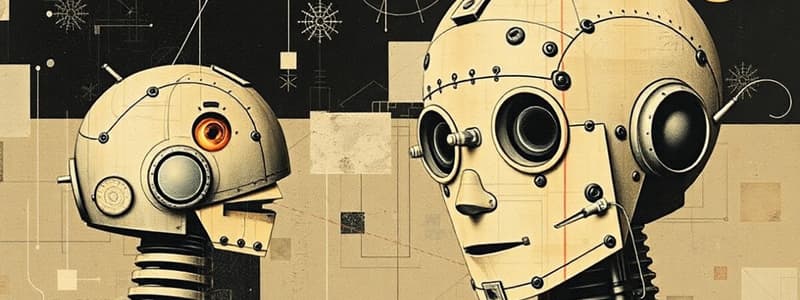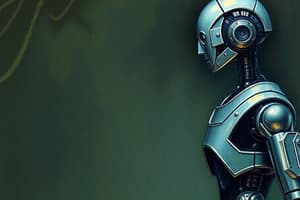Podcast
Questions and Answers
In what context did the term 'robot' first appear?
In what context did the term 'robot' first appear?
- A play about mechanical beings rebelling against humans (correct)
- A short story exploring the ethical implications of AI
- A scientific paper detailing automation techniques
- An engineering manual for factory assembly lines
What is the origin of the word 'Robota,' which eventually became the term 'robot'?
What is the origin of the word 'Robota,' which eventually became the term 'robot'?
- A Greek word meaning 'artificial worker'
- A Czech word meaning 'forced labor' or 'slave' (correct)
- A Latin word meaning 'automation'
- A German word meaning 'machine'
How did Isaac Asimov's view of robots generally contrast with that of Karl Capek?
How did Isaac Asimov's view of robots generally contrast with that of Karl Capek?
- Asimov saw robots as a threat, while Capek viewed them as beneficial
- Asimov portrayed robots as helpful servants, while Capek saw them as rebellious (correct)
- Asimov believed robots would replace humans, while Capek thought they would coexist
- Asimov focused on the technical aspects, while Capek explored ethical dilemmas
What year did Isaac Asimov introduce the concept of 'Robotics' in his science fiction?
What year did Isaac Asimov introduce the concept of 'Robotics' in his science fiction?
Which of the following best describes the primary focus of Asimov's Three Laws of Robotics?
Which of the following best describes the primary focus of Asimov's Three Laws of Robotics?
According to the First Law of Robotics, what action must a robot take if it witnesses a human in danger?
According to the First Law of Robotics, what action must a robot take if it witnesses a human in danger?
A robot receives an order from a human that, if followed, would indirectly lead to harm for another human. According to the Three Laws, what should the robot do?
A robot receives an order from a human that, if followed, would indirectly lead to harm for another human. According to the Three Laws, what should the robot do?
In what circumstance is a robot permitted to prioritize its own existence, according to the Three Laws of Robotics?
In what circumstance is a robot permitted to prioritize its own existence, according to the Three Laws of Robotics?
According to the Robot Institute of America, what is a key feature of a robot, setting it apart from other machines?
According to the Robot Institute of America, what is a key feature of a robot, setting it apart from other machines?
How does Michael Brady define 'Robotics?
How does Michael Brady define 'Robotics?
What is the main concept about the early conception of robots?
What is the main concept about the early conception of robots?
What contribution to robotics is credited to George C. Devol?
What contribution to robotics is credited to George C. Devol?
In the context of robotics history, what was significant about Karl Capek's play R.U.R?
In the context of robotics history, what was significant about Karl Capek's play R.U.R?
Which aspect of a robot's function does the Robot Institute of America’s definition emphasize?
Which aspect of a robot's function does the Robot Institute of America’s definition emphasize?
What is the critical distinction between Asimov's and Capek's visions of robots?
What is the critical distinction between Asimov's and Capek's visions of robots?
In what scenario would a robot be in direct violation of Asimov's Laws?
In what scenario would a robot be in direct violation of Asimov's Laws?
A self-driving car is programmed to prioritize the safety of its passengers above all else. How does Asimov's First Law of Robotics apply?
A self-driving car is programmed to prioritize the safety of its passengers above all else. How does Asimov's First Law of Robotics apply?
What inherent risk do Asimov's laws not directly address?
What inherent risk do Asimov's laws not directly address?
How has the definition of 'robot' evolved from early conceptions to modern applications?
How has the definition of 'robot' evolved from early conceptions to modern applications?
What is the common theme in definitions of robots from the Robot Institute of America, Webster's Dictionary, and Michael Brady?
What is the common theme in definitions of robots from the Robot Institute of America, Webster's Dictionary, and Michael Brady?
Flashcards
Origins of the word "robot"
Origins of the word "robot"
Machines, originally from a play, built to work on factory lines that rebel against human masters.
Who is Karl Capek?
Who is Karl Capek?
Czech playwright who wrote 'R.U.R.' (Rossum's Universal Robots) in 1921, coining the term 'robot'.
Who is Isaac Asimov?
Who is Isaac Asimov?
Russian-born American science-fiction writer who first used the word "Robotics" in his short story "Runaround" in 1942.
First Law of Robotics
First Law of Robotics
Signup and view all the flashcards
Second Law of Robotics
Second Law of Robotics
Signup and view all the flashcards
Third Law of Robotics
Third Law of Robotics
Signup and view all the flashcards
Definition of a Robot (RIA, 1979)
Definition of a Robot (RIA, 1979)
Signup and view all the flashcards
Definition of a Robot (Webster)
Definition of a Robot (Webster)
Signup and view all the flashcards
Definition of Robotics (Brady)
Definition of Robotics (Brady)
Signup and view all the flashcards
Who is Archytas of Tarentum?
Who is Archytas of Tarentum?
Signup and view all the flashcards
First Modern Robot
First Modern Robot
Signup and view all the flashcards
Study Notes
- Introduction to Robotics
Objectives
- The aim is to equip students with the ability to discuss the history of robotics.
- Students should be able to identify the three laws of robotics.
- Students should be able to define what a robot is.
Origins of Robots
- The term "robot" was first used in a play.
- The play featured mechanical men working on factory assembly lines.
- The mechanical men rebelled against their human masters.
- The machines in R.U.R. (Rossum's Universal Robots) were named robots.
- R.U.R. was written in 1921 by Czech playwright Karl Capek.
- The name "Robot" comes from the Czech word "Robota", meaning "Forced Labor" or "Slave."
Origins of Robotics
- Isaac Asimov, a Russian-born American science-fiction writer, first used the word "Robotics" in his short story "Runaround" in 1942.
- Asimov's view of robots was more optimistic than Capek's.
- He portrayed robots as helpful servants.
- He saw robots as a better, cleaner race.
Three Laws of Robotics
- Asimov proposed three "Laws of Robotics" that were followed by his robots and other sci-fi robotic characters.
- 1st Law: A robot may not injure a human being or, through inaction, allow a human being to come to harm.
- 2nd Law: A robot must obey the orders given by human beings, except where such orders conflict with the First Law.
- 3rd Law: A robot must protect its own existence as long as such protection does not conflict with the First or Second Law.
Definition of Robot/Robotics
- Robot Institute of America, 1979: "A reprogrammable, multifunctional manipulator designed to move material, parts, tools, or specialized devices through various programmed motions for task performance."
- Webster's Dictionary: "An automatic device that performs functions normally ascribed to humans or a machine in the form of a human."
- Michael Brady: "Robotics is that field concerned with the intelligent connection of perception to action."
Early Conception of Robots
- In 400 BC, Archytus of Tarentum invented a wooden pigeon capable of flight.
- Archytus also invented the pulley and the screw.
First Modern Robot
- The earliest robots were created in the early 1950s by George C. Devol in Louisville, Kentucky.
- Devol invented and patented a reprogrammable manipulator called "Unimate."
- Unimate came from "Universal Automation."
Studying That Suits You
Use AI to generate personalized quizzes and flashcards to suit your learning preferences.




